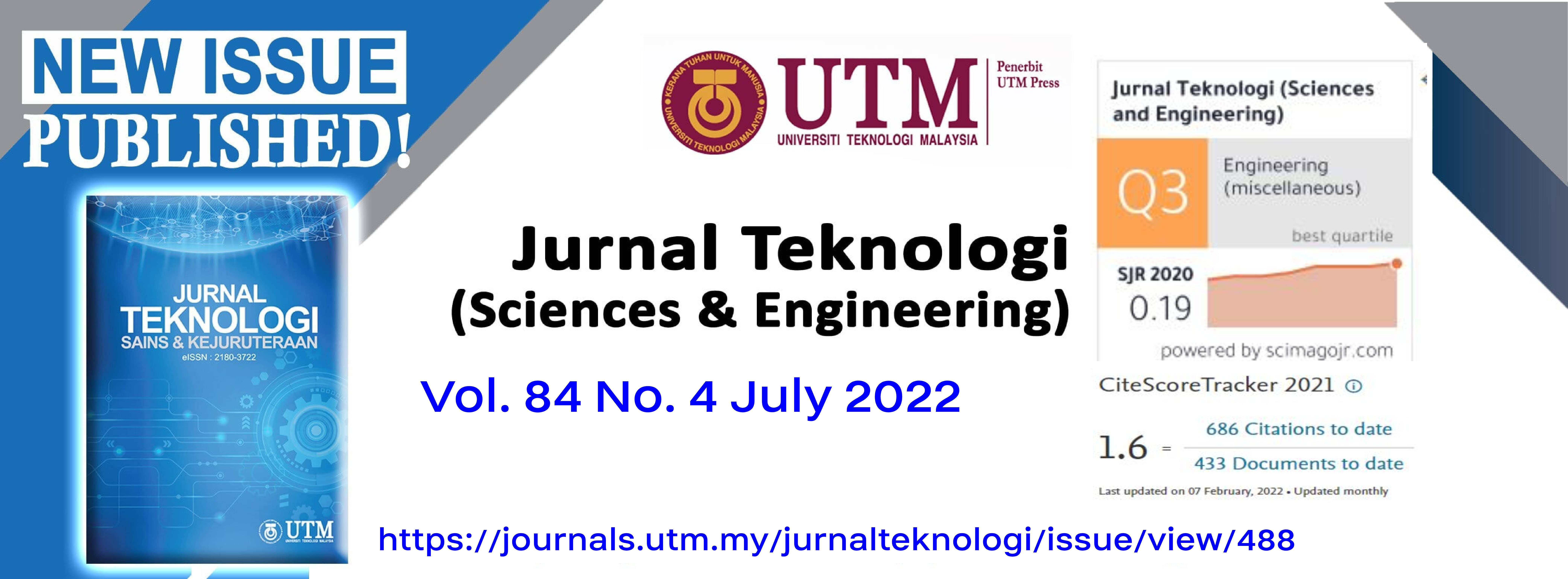OPTIMIZATION AND VERIFICATION OF DOUBLE LAYER BEAM SHAPING ASSEMBLY (DLBSA) FOR EPITHERMAL NEUTRON GENERATION
DOI:
https://doi.org/10.11113/jurnalteknologi.v84.18047Keywords:
DLBSA optimization, verification, epithermal neutron, MCNPX, PHITS, BNCTAbstract
The designs of Beam Shaping Assembly (BSA) for moderating fast neutron into epithermal neutron have been conducted. Some BSA models that are previously developed are still having problems in generating epithermal neutron. Instead, we propose designs of double layer beam shaping assembly (DLBSA) to produce epithermal neutron. Optimization of the Double Layer Beam Shaping Assembly (DLBSA) design was carried out using the genetic algorithm (AG) method using MCNPX and verified using the Particle and Heavy Ion Transport code System (PHITS). The optimization resulted in four configurations up to the 21st generation capable of producing epithermal neutron beams that comply with the IAEA standards. The best four configurations are obtained by combining: (1) Al with one of the CaF2, BiF3 or PbF2 materials as moderator, (2) Pb with Pb, Ni, or Bi as a reflector, (3) Ni with FeC, or C as collimator, (4) (FeC + LiF) as fast neutron filter, Cd or B4C as thermal neutron filter. Verification of the four optimum configurations of the DLBSA model using PHITS code shows that the epithermal neutron beam produced by DLBSA has met the IAEA standards.
References
Yura, Y., Fujita, Y. 2013. Boron Neutron Capture Therapy as a Novel Modality of Radiotherapy for Oral Cancer: Principle and Antitumor Effect. Oral Science International. 10(1): 9-14. http://dx.doi.org/10.1016/S1348-8643(12)00046-8.
Sauerwein, W. A. G. 2012. Neutron Capture Therapy. New York. Springer.
Taskaev, S. Y., Kanygin, V. V., Byvaltsev, V. A., Zaboronok, A. A., Volkova, O. Y., Mechetina, L. V., Nakai, K. 2018. Opportunities for using an Accelerator-based Epithermal Neutron Source for Boron Neutron Capture Therapy. Biomedical Engineering. 52(2): 73-76. http://dx.doi.org/10.1007/s10527-018-9785-0.
Peng, M., He, G. Z., Zhang, Q. W., Shi, B., Tang, H. Q., Zhou, Z. Y., 2019. Study of Neutron Production and Moderation for Sulfur Neutron Capture Therapy. Nuclear Science and Techniques. 30(1): 2. http://dx.doi.org/10.1007/s41365-018-0529-3.
Kreiner, A. J., Bergueiro, J., Cartelli, D., Baldo, M., Castell, W., Asoia, J. G., Mercuri, D. 2016. Present Status of Accelerator-based BNCT. Reports of Practical Oncology & Radiotherapy. 21(2): 95-101. http://dx.doi.org/10.1016/j.rpor.2014.11.004.
Kiyanagi, Y. 2018. Accelerator-based Neutron Source for Boron Neutron Capture Therapy. Therapeutic Radiology and Oncology. 2. http://dx.doi.org/10.21037/tro.2018.10.05.
Zaidi, L., Kashaeva, E. A., Lezhnin, S. I., Malyshkin, G. N., Samarin, S. I., Sycheva, T. V., Frolov, S. A. 2017. Neutron-beam-shaping Assembly for Boron Neutron-capture Therapy. Physics of Atomic Nuclei. 80(1): 60-66. http://dx.doi.org/10.1134/S106377881701015X.
International Atomic Energy Agency. 2001. Current Status of Neutron Capture Therapy, Vienna.
Tanaka, H., Sakurai, Y., Suzuki, M., Masunaga, S., Mitsumoto, T., Fujita, K., Ono, K. 2011. Experimental Verification of Beam Characteristics for Cyclotron-based Epithermal Neutron Source (C-BENS). Applied Radiation and Isotopes. 69(12): 1642-1645. http://dx.doi.org/10.1016/j.apradiso.2011.03.020.
Hashimoto, Y., Hiraga, F., Kiyanagi, Y. 2015. Optimal Moderator Materials at Various Proton Energies Considering Photon Dose Rate After Irradiation for an Accelerator-driven 9Be(p,n) Boron Neutron Capture Therapy Neutron Source. Applied Radiation and Isotopes. 106: 88-91. http://dx.doi.org/10.1016/j.apradiso.2015.07.027.
Khorshidi, A. 2017. Accelerator Driven Neutron Source Design via Beryllium Target and 208Pb Moderator for Boron Neutron Capture Therapy in Alternative Treatment Strategy by Monte Carlo Method. Journal of Cancer Research and Therapeutics. 13(3): 456. http://dx.doi.org/10.4103/0973-1482.179180.
Rasouli, F. S., Masoudi S. F. 2012. Design and Optimization of a Beam Shaping Assembly for BNCT based on D–T Neutron Generator and Dose Evaluation using a Simulated Head Phantom. Applied Radiation and Isotopes. 70(12): 2755. http://dx.doi.org/10.1016/j.apradiso.2012.08.008.
Fantidis, G. J., Nicolaou, G. 2018. Optimization of Beam Shaping Assembly design for Boron Neutron Capture Therapy based on a Transportable Proton Accelerator. Alexandria Engineering Journal. 57: 2333-2342. http://dx.doi.org/10.1016/j.aej.2017.08.004.
Kasesaz, Y., Khalafi, H., Rahmani, F. 2014. Design of an Epithermal Neutron Beam for BNCT in Thermal Column of Tehran Research Reactor. Annals of Nuclear Energy. 68: 234-238. http://dx.doi.org/ 10.1016/j.anucene.2014.01.014.
Hu, G., Hu, H. S., Wang, S., Pan, Z. H., Jia, Q. G., Yan, M. F.,Yan, M. F. 2016. The Neutron Channel Design— A Method for Gaining the Desired Neutrons. AIP Advances. 6: 1-12. https://doi.org/10.1063/1.4972203.
Turkmen, M., Ergun, S., Colak, U. 2017. A New Method in Beam Shaping: Multi-objective Genetic Algorithm Method Coupled with a Monte Carlo based Reactor Physics Code. Progress in Nuclear Energy. 99: 165-176. https://doi.org/10.1016/j.pnucene.2017.05.008.
Rocha, I. B. C. M., Parente Jr, E., Melo, A. M. C. 2014. A Hybrid Shared/distributed Memory Parallel Genetic Algorithm for Optimization of Laminate Composites. Composite structures. 107: 288-297. http://dx.doi.org/10.1016/j.compstruct.2013.07.049.
Kim, S, B., & Moon, H, J. 2010. Use of a Genetic Algorithm in the Search for a Near-optimal Shielding Design. Annals of Nuclear Energy. 37: 120-129, https://doi.org/10.1016/j.anucene.2009.11.014.
Pelowitz, D. B. 2005. MCNPXTM User’s Manual. Los Alamos National Laboratory, Los Alamos. https://www.mcnp.ir/admin/imgs/1354176297.2.6.0_Users_Manual.pdf.
Sato, T., Niita, K., Matsuda, N., Hashimoto, S., Iwamoto, Y., Noda, S., Okumura, K. 2013. Particle and Heavy Ion Transport Code System PHITS, version 2.52. Journal of Nuclear Science and Technology. 50(9): 913-923.
http://dx.doi.org/10.1080/00223131.2013.814553.
Aghara, S. K., Sriprisan, S. I., Singleterry, R. C., & Sato, T. 2015. Shielding Evaluation for Solar Particle Events using MCNPX, PHITS and OLTARIS Codes. Life Sciences in Space Research. 4: 79-91.
https://doi.org/10.1016/j.lssr.2014.12.003.
Shaaban, I., Albarhoum, M. 2015. Design Calculation of an Epithermal Neutronic Beam for BNCT at the Syrian MNSR using the MCNP4C Code. Progress in Nuclear Energy. 78: 297-302. http://dx.doi.org/10.1016/j.pnucene.2014.10.00 5.
Faghihi, F., Khalili, S. 2013. Beam Shaping Assembly of a D – T Neutron Source for BNCT and its Dosimetry Simulation in Deeply-seated Tumor. Radiation Physics and Chemistry. 89: 1-13.
https://doi.org/10.1016/j.radphyschem.2013.02.003.
Yang, Z. Y., Tsai, P. E., Lee, S. C., Liu, Y. C., Chen, C. C., Sato, T., Sheu, R. J. 2017. Inter-comparison of Dose Distributions Calculated by FLUKA, GEANT4, MCNP, and PHITS for Proton Therapy. EPJ Web of Conferences. 153: 04011. EDP Sciences.
Downloads
Published
Issue
Section
License
Copyright of articles that appear in Jurnal Teknologi belongs exclusively to Penerbit Universiti Teknologi Malaysia (Penerbit UTM Press). This copyright covers the rights to reproduce the article, including reprints, electronic reproductions, or any other reproductions of similar nature.
















